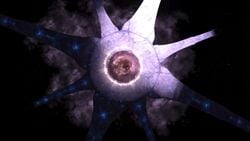Ark
From Halopedia, the Halo wiki
Ark is a name given to two massive Forerunner installations, both designed with the primary purpose of manufacturing Halo rings.[1][2] Situated outside the Milky Way galaxy, they also served as Lifeworker research facilities, as well as conservational preserves for the numerous species of the galaxy, indexed by the Forerunners during the Conservation Measure.[3][4] The Arks were shaped like massive flowers, consisting of several curved arms, similar to the petals of a flower, surrounding a circular Halo construction foundry in the center.[5]
Two Arks existed during the Forerunner-Flood war; the greater Ark, which produced the original array of Halos 30,000 kilometers in diameter, and Installation 00 or the lesser Ark, which produced a newer series of rings each 10,000 kilometers in diameter. Both of these constructs are known to have been distinctly referred to as "the Ark"; originally, the term was more commonly applied to the greater Ark, whereas the lesser Ark and its newer, more efficient array of Halos was kept a well-guarded secret among Forerunners. With the greater Ark destroyed in the final days of the Flood war,[6] the lesser Ark remained as the only Ark installation and is as such commonly known as "the Ark".[7]
History[edit]

- Main article: History of the Halo Array
The greater Ark was created some time following the end of the human-Forerunner wars, when an extreme faction of Builders, led by Master Builder Faber, began working on the first Halo rings as their solution to the Flood threat. However, due to opposition by the Didact and the rest of the Prometheans, the construction of the Halos was delayed for thousands of years. After the Master Builder successfully eliminated his opposition and work on the Halos commenced, the Librarian went before the Ecumene Council and invoked the Mantle, stating that a contingency plan was needed for galactic life in the event the Halo installations were ever used. This plan, known as the Conservation Measure, entailed the incorporation of extensive biological preserves on the facilities of the Array, including the Halos and the Arks.[3] The Builders saw this as an agreeable compromise as the inclusion of Lifeworker conservation preserves mitigated the otherwise destructive purpose of the Halos in the eyes of the Council and allowed them to compete with the Didact's shield worlds.[8]
The first Ark ultimately constructed twelve Halo rings, each 30,000 kilometers in diameter, designed by Wise-Hands-to-Forge's guild.[3] However, the deficiencies with the greater Ark and its Halos were soon noted among the Builders, one of the most major being the excessive size of the original rings which made them unwieldy to transport and prone to instability. While plans were made for smaller, more efficient Halos, the greater Ark's Foundry was found to be incapable of producing installations of a different size. The Master Builder was reluctant to admit the shortcomings of the greater Ark and even had its critics persecuted, but eventually yielded and commissioned the creation of a second Ark and with it smaller but more powerful Halos; this construct was known as the lesser Ark, or Installation 00. While plans for the second Ark were created fairly early on, its construction was delayed for some time by the Council out of fear of making the Builders too powerful to be controlled.[8] Despite the in many ways more impressive technology incorporated to the lesser Ark,[9] Faber would always regard the original Ark and its Halos as his prize project.[10]
List of appearances[edit]
|
|
Sources[edit]
- ^ Halo: Primordium page 343 ("...one of the two Arks that had created them in the first place.")
- ^ Halo: Primordium page 375 ("...neither of the Arks were manufacturing Halos...")
- ^ a b c Halo: Cryptum, pages 273-275
- ^ Halo: Primordium, pages 372-373
- ^ Halo: Primordium, page 371
- ^ Halo Silentium
- ^ Halo 3
- ^ a b Halo: Silentium, pages 44-45
- ^ Halo: Silentium, pages 311-312
- ^ Halo: Silentium, page 270